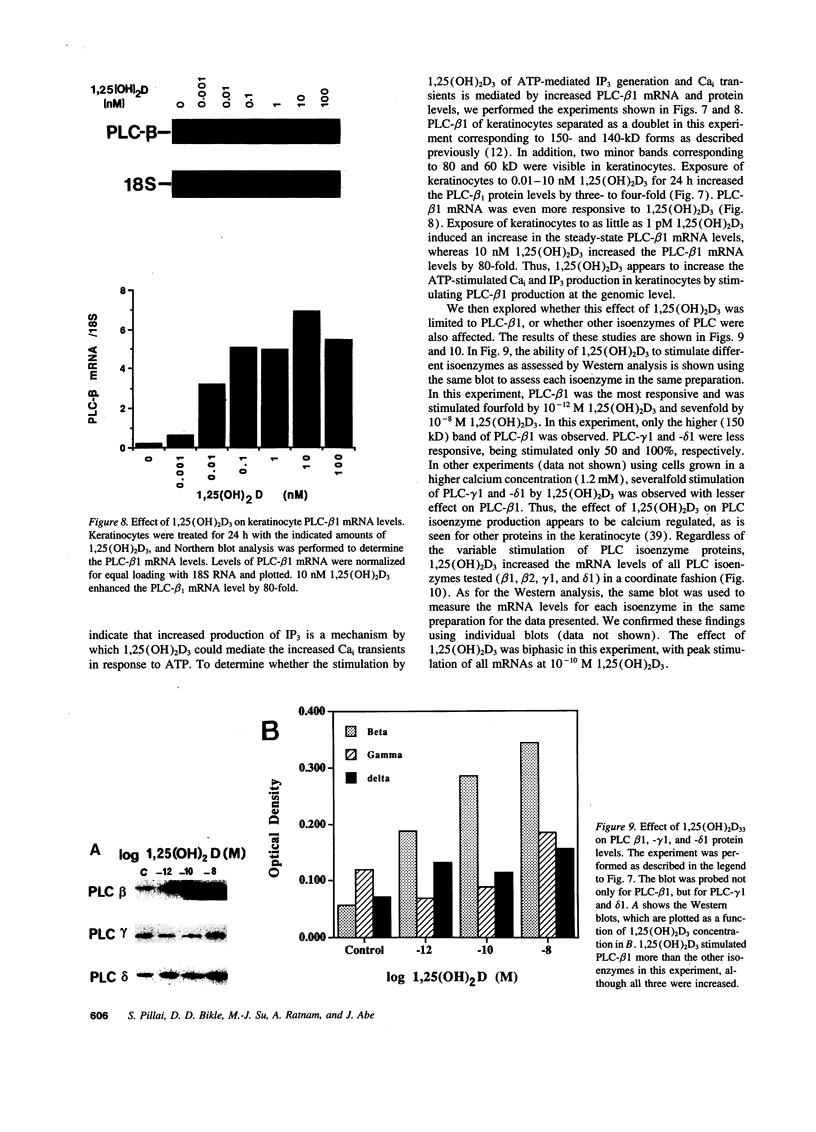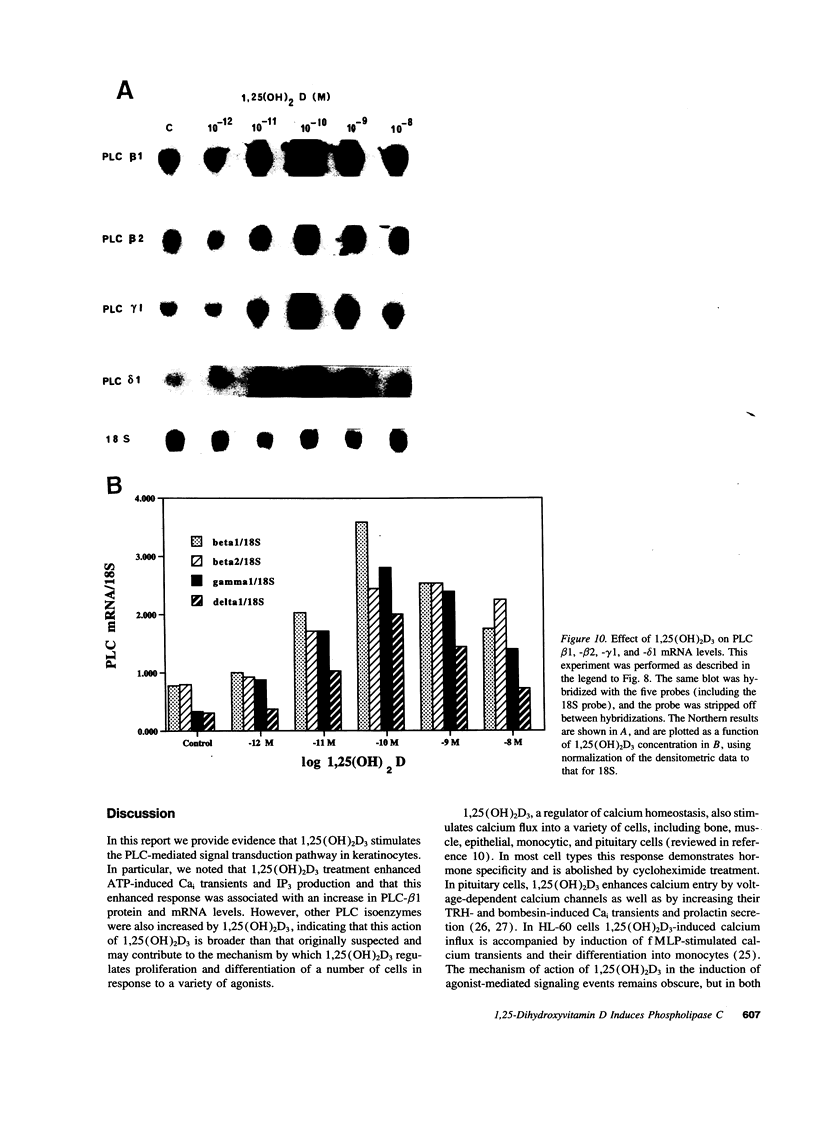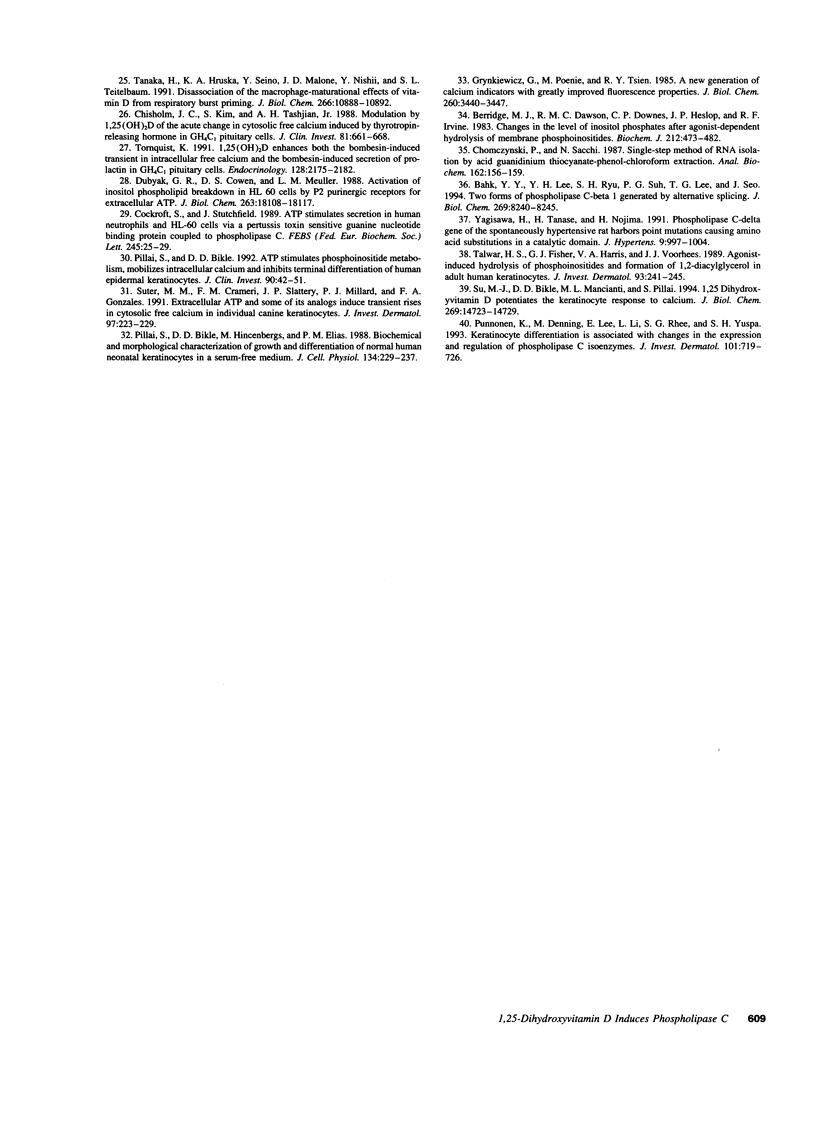Abstract
1,25-Dihydroxyvitamin D3 (1,25(OH)2D3) induces the differentiation of normal human keratinocytes, in part by increasing their basal intracellular calcium levels (Cai) over a period of hours. Agonists such as ATP acting through membrane receptors cause an immediate but transient increase in Cai accompanied by an increase in inositol trisphosphate (IP3). Treatment of keratinocytes for 24 h with 1 nM 1,25(OH)2D3 resulted in a two- to four-fold potentiation of the Cai response of these cells to ATP. This potentiation was inhibitable with cycloheximide, unaccompanied by a change in total intracellular calcium pools, but associated with an increase in basal IP3 levels and ATP-stimulated IP3 production. Treatment with 1,25(OH)2D3 raised the protein and mRNA levels of phospholipase C isoenzymes, particularly phospholipase C-beta 1 in a dose-dependent manner. These studies indicate that 1,25(OH)2D3 modulates the keratinocyte signal transduction pathway by induction of phospholipase isoenzymes, a previously undescribed action for this hormone.
Full text
PDF







Images in this article
Selected References
These references are in PubMed. This may not be the complete list of references from this article.
- Bahk Y. Y., Lee Y. H., Lee T. G., Seo J., Ryu S. H., Suh P. G. Two forms of phospholipase C-beta 1 generated by alternative splicing. J Biol Chem. 1994 Mar 18;269(11):8240–8245. [PubMed] [Google Scholar]
- Berridge M. J., Dawson R. M., Downes C. P., Heslop J. P., Irvine R. F. Changes in the levels of inositol phosphates after agonist-dependent hydrolysis of membrane phosphoinositides. Biochem J. 1983 May 15;212(2):473–482. doi: 10.1042/bj2120473. [DOI] [PMC free article] [PubMed] [Google Scholar]
- Bittiner B., Bleehen S. S., MacNeil S. 1 alpha,25(OH)2 vitamin D3 increases intracellular calcium in human keratinocytes. Br J Dermatol. 1991 Mar;124(3):230–235. doi: 10.1111/j.1365-2133.1991.tb00566.x. [DOI] [PubMed] [Google Scholar]
- Boyce S. T., Ham R. G. Calcium-regulated differentiation of normal human epidermal keratinocytes in chemically defined clonal culture and serum-free serial culture. J Invest Dermatol. 1983 Jul;81(1 Suppl):33s–40s. doi: 10.1111/1523-1747.ep12540422. [DOI] [PubMed] [Google Scholar]
- Chisholm J. C., Kim S., Tashjian A. H., Jr Modulation by 1,25-dihydroxycholecalciferol of the acute change in cytosolic free calcium induced by thyrotropin-releasing hormone in GH4C1 pituitary cells. J Clin Invest. 1988 Mar;81(3):661–668. doi: 10.1172/JCI113370. [DOI] [PMC free article] [PubMed] [Google Scholar]
- Chomczynski P., Sacchi N. Single-step method of RNA isolation by acid guanidinium thiocyanate-phenol-chloroform extraction. Anal Biochem. 1987 Apr;162(1):156–159. doi: 10.1006/abio.1987.9999. [DOI] [PubMed] [Google Scholar]
- Cockcroft S., Stutchfield J. ATP stimulates secretion in human neutrophils and HL60 cells via a pertussis toxin-sensitive guanine nucleotide-binding protein coupled to phospholipase C. FEBS Lett. 1989 Mar 13;245(1-2):25–29. doi: 10.1016/0014-5793(89)80184-x. [DOI] [PubMed] [Google Scholar]
- Dlugosz A. A., Yuspa S. H. Coordinate changes in gene expression which mark the spinous to granular cell transition in epidermis are regulated by protein kinase C. J Cell Biol. 1993 Jan;120(1):217–225. doi: 10.1083/jcb.120.1.217. [DOI] [PMC free article] [PubMed] [Google Scholar]
- Dubyak G. R., Cowen D. S., Meuller L. M. Activation of inositol phospholipid breakdown in HL60 cells by P2-purinergic receptors for extracellular ATP. Evidence for mediation by both pertussis toxin-sensitive and pertussis toxin-insensitive mechanisms. J Biol Chem. 1988 Dec 5;263(34):18108–18117. [PubMed] [Google Scholar]
- Grynkiewicz G., Poenie M., Tsien R. Y. A new generation of Ca2+ indicators with greatly improved fluorescence properties. J Biol Chem. 1985 Mar 25;260(6):3440–3450. [PubMed] [Google Scholar]
- Hennings H., Michael D., Cheng C., Steinert P., Holbrook K., Yuspa S. H. Calcium regulation of growth and differentiation of mouse epidermal cells in culture. Cell. 1980 Jan;19(1):245–254. doi: 10.1016/0092-8674(80)90406-7. [DOI] [PubMed] [Google Scholar]
- Hosomi J., Hosoi J., Abe E., Suda T., Kuroki T. Regulation of terminal differentiation of cultured mouse epidermal cells by 1 alpha,25-dihydroxyvitamin D3. Endocrinology. 1983 Dec;113(6):1950–1957. doi: 10.1210/endo-113-6-1950. [DOI] [PubMed] [Google Scholar]
- Hruska K. A., Bar-Shavit Z., Malone J. D., Teitelbaum S. Ca2+ priming during vitamin D-induced monocytic differentiation of a human leukemia cell line. J Biol Chem. 1988 Nov 5;263(31):16039–16044. [PubMed] [Google Scholar]
- Jaken S., Yuspa S. H. Early signals for keratinocyte differentiation: role of Ca2+-mediated inositol lipid metabolism in normal and neoplastic epidermal cells. Carcinogenesis. 1988 Jun;9(6):1033–1038. doi: 10.1093/carcin/9.6.1033. [DOI] [PubMed] [Google Scholar]
- Jones K. T., Sharpe G. R. Staurosporine, a non-specific PKC inhibitor, induces keratinocyte differentiation and raises intracellular calcium, but Ro31-8220, a specific inhibitor, does not. J Cell Physiol. 1994 May;159(2):324–330. doi: 10.1002/jcp.1041590215. [DOI] [PubMed] [Google Scholar]
- Lee E., Yuspa S. H. Aluminum fluoride stimulates inositol phosphate metabolism and inhibits expression of differentiation markers in mouse keratinocytes. J Cell Physiol. 1991 Jul;148(1):106–115. doi: 10.1002/jcp.1041480113. [DOI] [PubMed] [Google Scholar]
- MacLaughlin J. A., Cantley L. C., Holick M. F. 1,25(OH)2D3 increases calcium and phosphatidylinositol metabolism in differentiating cultured human keratinocytes. J Nutr Biochem. 1990 Feb;1(2):81–87. doi: 10.1016/0955-2863(90)90054-o. [DOI] [PubMed] [Google Scholar]
- Mezzetti G., Monti M. G., Casolo L. P., Piccinini G., Moruzzi M. S. 1,25-Dihydroxycholecalciferol-dependent calcium uptake by mouse mammary gland in culture. Endocrinology. 1988 Feb;122(2):389–394. doi: 10.1210/endo-122-2-389. [DOI] [PubMed] [Google Scholar]
- Norman A. W., Roth J., Orci L. The vitamin D endocrine system: steroid metabolism, hormone receptors, and biological response (calcium binding proteins). Endocr Rev. 1982 Fall;3(4):331–366. doi: 10.1210/edrv-3-4-331. [DOI] [PubMed] [Google Scholar]
- O'Driscoll K. R., Madden P. V., Christiansen K. M., Viage A., Slaga T. J., Fabbro D., Powell C. T., Weinstein I. B. Overexpression of protein kinase C beta I in a murine keratinocyte cell line produces effects on cellular growth, morphology and differentiation. Cancer Lett. 1994 Aug 15;83(1-2):249–259. doi: 10.1016/0304-3835(94)90327-1. [DOI] [PubMed] [Google Scholar]
- Park D. J., Min H. K., Rhee S. G. Inhibition of CD3-linked phospholipase C by phorbol ester and by cAMP is associated with decreased phosphotyrosine and increased phosphoserine contents of PLC-gamma 1. J Biol Chem. 1992 Jan 25;267(3):1496–1501. [PubMed] [Google Scholar]
- Pillai S., Bikle D. D. Adenosine triphosphate stimulates phosphoinositide metabolism, mobilizes intracellular calcium, and inhibits terminal differentiation of human epidermal keratinocytes. J Clin Invest. 1992 Jul;90(1):42–51. doi: 10.1172/JCI115854. [DOI] [PMC free article] [PubMed] [Google Scholar]
- Pillai S., Bikle D. D., Elias P. M. 1,25-Dihydroxyvitamin D production and receptor binding in human keratinocytes varies with differentiation. J Biol Chem. 1988 Apr 15;263(11):5390–5395. [PubMed] [Google Scholar]
- Pillai S., Bikle D. D. Epidermal vitamin D metabolism, function, and regulation. Adv Lipid Res. 1991;24:321–341. doi: 10.1016/b978-0-12-024924-4.50015-8. [DOI] [PubMed] [Google Scholar]
- Pillai S., Bikle D. D., Hincenbergs M., Elias P. M. Biochemical and morphological characterization of growth and differentiation of normal human neonatal keratinocytes in a serum-free medium. J Cell Physiol. 1988 Feb;134(2):229–237. doi: 10.1002/jcp.1041340208. [DOI] [PubMed] [Google Scholar]
- Pillai S., Bikle D. D. Role of intracellular-free calcium in the cornified envelope formation of keratinocytes: differences in the mode of action of extracellular calcium and 1,25 dihydroxyvitamin D3. J Cell Physiol. 1991 Jan;146(1):94–100. doi: 10.1002/jcp.1041460113. [DOI] [PubMed] [Google Scholar]
- Punnonen K., Denning M., Lee E., Li L., Rhee S. G., Yuspa S. H. Keratinocyte differentiation is associated with changes in the expression and regulation of phospholipase C isoenzymes. J Invest Dermatol. 1993 Nov;101(5):719–726. doi: 10.1111/1523-1747.ep12371682. [DOI] [PubMed] [Google Scholar]
- Reichel H., Koeffler H. P., Norman A. W. The role of the vitamin D endocrine system in health and disease. N Engl J Med. 1989 Apr 13;320(15):980–991. doi: 10.1056/NEJM198904133201506. [DOI] [PubMed] [Google Scholar]
- Ryu S. H., Kim U. H., Wahl M. I., Brown A. B., Carpenter G., Huang K. P., Rhee S. G. Feedback regulation of phospholipase C-beta by protein kinase C. J Biol Chem. 1990 Oct 15;265(29):17941–17945. [PubMed] [Google Scholar]
- Smith E. L., Walworth N. C., Holick M. F. Effect of 1 alpha,25-dihydroxyvitamin D3 on the morphologic and biochemical differentiation of cultured human epidermal keratinocytes grown in serum-free conditions. J Invest Dermatol. 1986 Jun;86(6):709–714. doi: 10.1111/1523-1747.ep12276343. [DOI] [PubMed] [Google Scholar]
- Su M. J., Bikle D. D., Mancianti M. L., Pillai S. 1,25-Dihydroxyvitamin D3 potentiates the keratinocyte response to calcium. J Biol Chem. 1994 May 20;269(20):14723–14729. [PubMed] [Google Scholar]
- Suter M. M., Crameri F. M., Slattery J. P., Millard P. J., Gonzalez F. A. Extracellular ATP and some of its analogs induce transient rises in cytosolic free calcium in individual canine keratinocytes. J Invest Dermatol. 1991 Aug;97(2):223–229. doi: 10.1111/1523-1747.ep12480162. [DOI] [PubMed] [Google Scholar]
- Talwar H. S., Fisher G. J., Harris V. A., Voorhees J. J. Agonist-induced hydrolysis of phosphoinositides and formation of 1,2-diacylglycerol in adult human keratinocytes. J Invest Dermatol. 1989 Aug;93(2):241–245. doi: 10.1111/1523-1747.ep12277581. [DOI] [PubMed] [Google Scholar]
- Tanaka H., Hruska K. A., Seino Y., Malone J. D., Nishii Y., Teitelbaum S. L. Disassociation of the macrophage-maturational effects of vitamin D from respiratory burst priming. J Biol Chem. 1991 Jun 15;266(17):10888–10892. [PubMed] [Google Scholar]
- Tang W., Ziboh V. A., Isseroff R. R., Martinez D. Novel regulatory actions of 1 alpha,25-dihydroxyvitamin D3 on the metabolism of polyphosphoinositides in murine epidermal keratinocytes. J Cell Physiol. 1987 Jul;132(1):131–136. doi: 10.1002/jcp.1041320118. [DOI] [PubMed] [Google Scholar]
- Törnquist K. 1,25-Dihydroxycholecalciferol enhances both the bombesin-induced transient in intracellular free Ca2+ and the bombesin-induced secretion of prolactin in GH4C1 pituitary cells. Endocrinology. 1991 Apr;128(4):2175–2182. doi: 10.1210/endo-128-4-2175. [DOI] [PubMed] [Google Scholar]
- Walters M. R. Steroid hormone receptors and the nucleus. Endocr Rev. 1985 Fall;6(4):512–543. doi: 10.1210/edrv-6-4-512. [DOI] [PubMed] [Google Scholar]
- Yada Y., Ozeki T., Meguro S., Mori S., Nozawa Y. Signal transduction in the onset of terminal keratinocyte differentiation induced by 1 alpha,25-dihydroxyvitamin D3: role of protein kinase C translocation. Biochem Biophys Res Commun. 1989 Sep 29;163(3):1517–1522. doi: 10.1016/0006-291x(89)91152-2. [DOI] [PubMed] [Google Scholar]
- Yagisawa H., Tanase H., Nojima H. Phospholipase C-delta gene of the spontaneously hypertensive rat harbors point mutations causing amino acid substitutions in a catalytic domain. J Hypertens. 1991 Nov;9(11):997–1004. doi: 10.1097/00004872-199111000-00004. [DOI] [PubMed] [Google Scholar]







